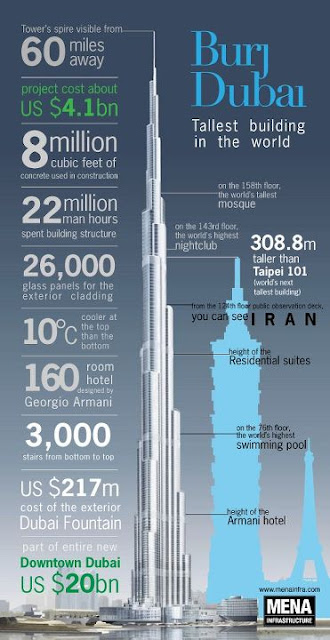Official name: Burj Khalifa Bin Zayed
Also known as: Burj Dubai
Also known as: Tower of Khalifa
Formerly: Burj Dubai
Built: 2004-2010
Cost: $4,100,000,000
Designed by: Skidmore, Owings & Merrill
Type: Skyscraper
Stories: 206
Maximum Height: 2,717 feet / 828 meters
Location: No. 1, Burj Dubai Boulevard, Dubai, United Arab Emirates
Also known as: Burj Dubai
Also known as: Tower of Khalifa
Formerly: Burj Dubai
Built: 2004-2010
Cost: $4,100,000,000
Designed by: Skidmore, Owings & Merrill
Type: Skyscraper
Stories: 206
Maximum Height: 2,717 feet / 828 meters
Location: No. 1, Burj Dubai Boulevard, Dubai, United Arab Emirates
* The tower's glass and steel exterior would cover 17 football fields, and takes six to eight weeks to clean.
Legends
In the rarefied air occuped by construction workers, legends were born.
In December 2008, London's Telegraph wrote about "Babu Sassi", the operator of a crane perched at the peak of the hotel.
According to the paper, Sassi - from Kerala in southern India - was a cult hero on the site because of his fearlessness and dedication at remarkable altitudes.
"His office, the cramped crane cab perched on top of the Burj, is also his home — apparently it takes too long to come down to the ground each day to make it worthwhile," the Telegraph wrote.
It said he had been in the crane for about a year. The story spread quickly around the world.
But Sassi's existence was questioned.
“I presume much of it is just rumour and speculation,” Shaun Killa, a Dubai architect involved with the project told the Khaleej Times in November 2009, after the top floor was completed and the cranes were dismantled.
Height undecided
The Burj developers' audacious bid to build the world's tallest building was reflected in their dealings with designers.
As though operating under the motto "how long is a piece of string", engineers were apparently not set a final height specification, and consistently urged skyward by developers.
"We thought that it would be slightly taller than the existing tallest tower of Taipei 101. (But developer Emaar) kept on asking us to go higher but we didn't know how high we could go," said Bill Baker from Skidmore, Owings and Merrill (SOM), the company that designed the tower.
"We were able to tune the building like we tune a musical instrument. As we went higher and higher and higher, we discovered that by doing that process... we were able to reach heights much higher than we ever thought we could.
"We learned quite a bit from Burj Dubai. I would think we could easily do a one kilometre (tower). We are optimistic about the ability to go even higher."
How it was built
Developers used high-altitude tower cranes to achieve the breathtaking height of the Burj. The cranes were attached to the building and operated as high as 750 metres above ground level, lifting building materials from below, according the Gulf News.
Each crane was capable of lifting 25-tonnes and could withstand 120km/h winds. Crucial to the project's objective of breaking height records, the cranes could move up the tower as levels were completed.
"But as the tower grew in height, the floor plates and working area became smaller and smaller, providing insufficient room to fit the three cranes at the top of construction," developer Emaar said in a statement.
By the final stage of the project, two of the three cranes had clambered back down the tower's exterior, leaving one to complete construction.
In total, the cranes lifted 63,300 tonnes of steel reinforcement, ran for 45,000 man hours and were operated by 35 technicians.
Life in the cranes
Life in the cab of a crane 750 metres above ground was not always pleasant, according to construction company Arabtec. "At the top of the Burj the cranes and their operators had to endure all kinds of weather such as squally winds of up to 120 km per hour, dust clouds coming from the northwest, rain and fog and temperatures not far away from freezing point.
"In general the temperature at the top of the tower ranges between 7 to 8 degrees celsius cooler than at ground level."
But one burj operator told the Gulf News he was more concerned about other crane operators, rather than the weather.
"The biggest challenge is to stay focused and watch the crane traffic, to see which is moving towards or away from you. The cabin has air-conditioning and I have a heater so I can make coffee." said Gurjeet Singh, from India.
Bringing the cranes down
If erecting the tallest tower was a marvel of construction, bringing the equipment back down appears to have been just as significant a feat.
In what the developers called a "finely orchestrated set piece", the top-most crane partially dismantled itself, passing components down to one of the other cranes, which had earlier climbed down the tower.
"The crane removed its own mast sections and lowered them to the ground until the boom and power pack were at the position of the level 159 recovery crane.
"From there, the Level 159 recovery crane dismantled the remainder of the main crane, lowering the pieces of boom, mast and power pack to the recovery crane at Level 99, which further lowered them to the ground."
Who built the Burj?
The Burj was built by 10,000 construction workers from over 59 companies. Most workers were poor migrants from India, Pakistan and Bangladesh.
For many, visiting the top of the tower was a goal.
“I have never gone up. I am waiting for a chance to climb the building,” 23-year-old Bangladeshi
electrician Mohammed Ismail Hussain told UAE publication 7Days.
In 2006, about 2500 workers rioted over pay and conditions, causing damage estimated at $882,000.










0 comments:
Post a Comment